Coming from the American manufacturer’s range of festive speakers, the JBL PartyBox Stage 320 is located at the heart of a range opened by the small PartyBox Encore and dominated by the extraordinary JBL PartyBox Ultimate, which we had the opportunity to test — and enjoy. The PartyBox 320 seems a good compromise between size and acoustic performance. Its cabin luggage size, with wheels and telescopic handle, allows the speaker to be transported without too much difficulty, and allows the use of transducers of good diameter, useful for powerful and catchy reproduction of music. Like the Ultimate, the JBL PartyBox Stage 320 has guitar and microphone inputs, for trying out karaoke, and features multiple colored LED strips, ideal for creating a festive lighting atmosphere.
JBL PartyBox Stage 320 Technical sheet
| Model | JBL PartyBox Stage 320 |
|---|---|
| Number of speakers | 4 |
| Sound power | 240 watts |
| Autonomy announced | 6 p.m. |
| Built-in microphone | No |
| Bluetooth version | 5.3 |
| Protection sign | IPX4 |
Product sheet |
The enclosure used for this test was loaned by the manufacturer.
JBL PartyBox Stage 320 An extraordinary size
The JBL PartyBox Stage 320 is rather imposing, measuring 66 cm in height, 33 cm in width and approximately 38 cm in depth. It also weighs 16.5 kg, which prevents it from being transported as easily as JBL portable speakers (Boombox 3 WiFi, Xtreme 4, etc.). However, thanks to a handle at the top and a second under the speaker, it can be easily transported by two people or even alone. On regular ground, its casters and telescopic handle allow it to be rolled effortlessly.
The PartyBox Stage 320 is made entirely of plastic and covered on the front with an aluminum grille. The speakers behind the grille are surrounded by a “ path of light » which lights up according to the rhythm of the music. This customizable (and deactivable) lighting is associated with several small white LEDs to produce stroboscopic effects.
The control panel is housed at the top of the enclosure and has three zones. At the bottom are controls for power, volume, lighting, Bluetooth pairing, as well as the Bass Boost function. In the center, a small panel allows you to play a personalized sound effect (fog horn, scratch, etc.). At the top are housed the potentiometers for reinforcing bass and treble sounds, as well as those linked to any microphones or guitar that may be connected (echo, volume).
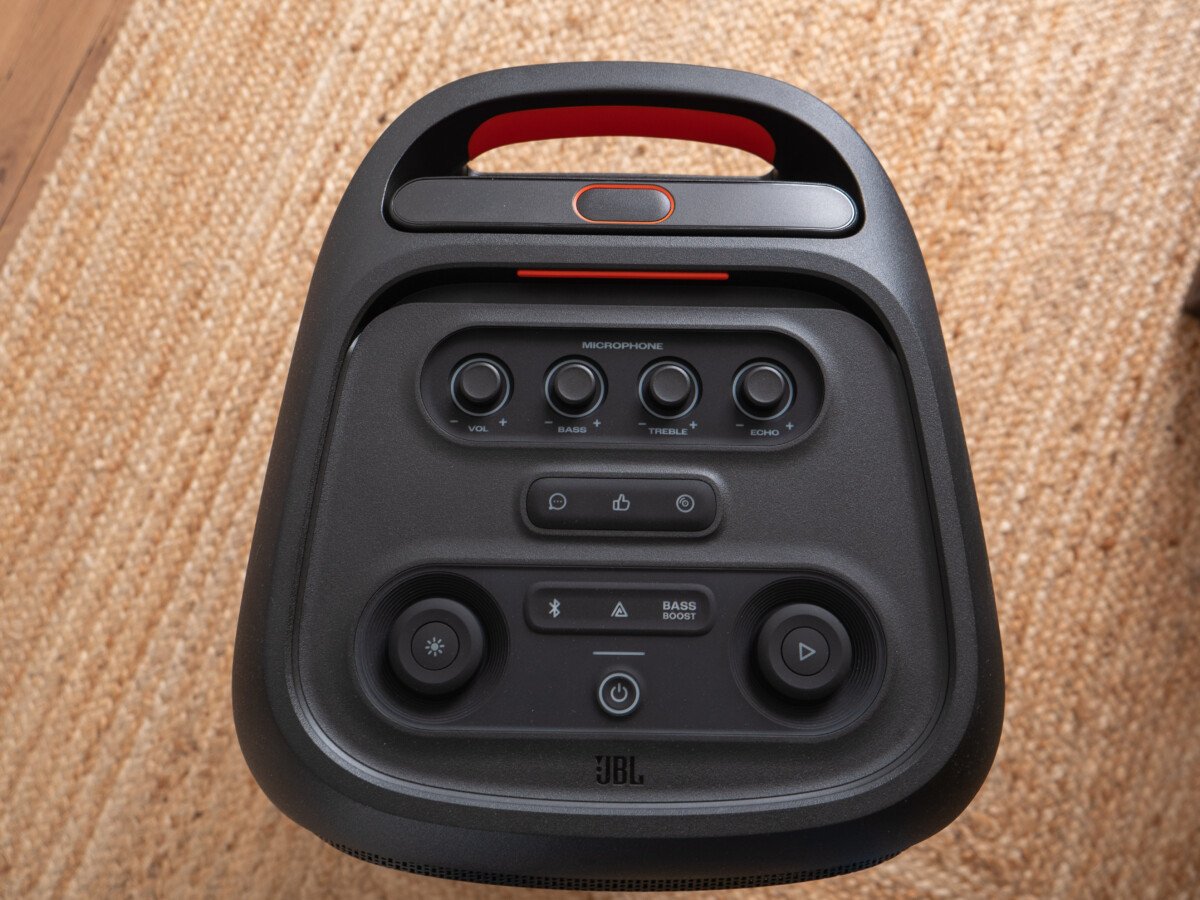
The rear panel houses three hatches, two for the audio input niches and the mains power supply, and a third in which the speaker battery is located. This is removable and can be easily replaced – JBL also offers it for sale. Finally, the JBL PartyBox Stage 320 is IPX4 certified, splash-proof and therefore safe to play by a pool or in light rain at the beach.
Acoustic design of the PartyBox Stage 320
JBL opted for a two-way audio system, with two 16.5 cm transducers stacked on the front and two dome tweeters installed horizontally just above. The 20 cm transducers are immersed in a tuned bass-reflex type load. As a reminder, the bass-reflex load makes it possible to increase the volume of very low frequencies while placing less demand on the transducers. The resonator is installed at the rear of the speaker and its port is very imposing, much more than that of hi-fi speakers for example. There’s a reason for this: the larger the outlet area of the vent, the lower the airflow noise at high volume.
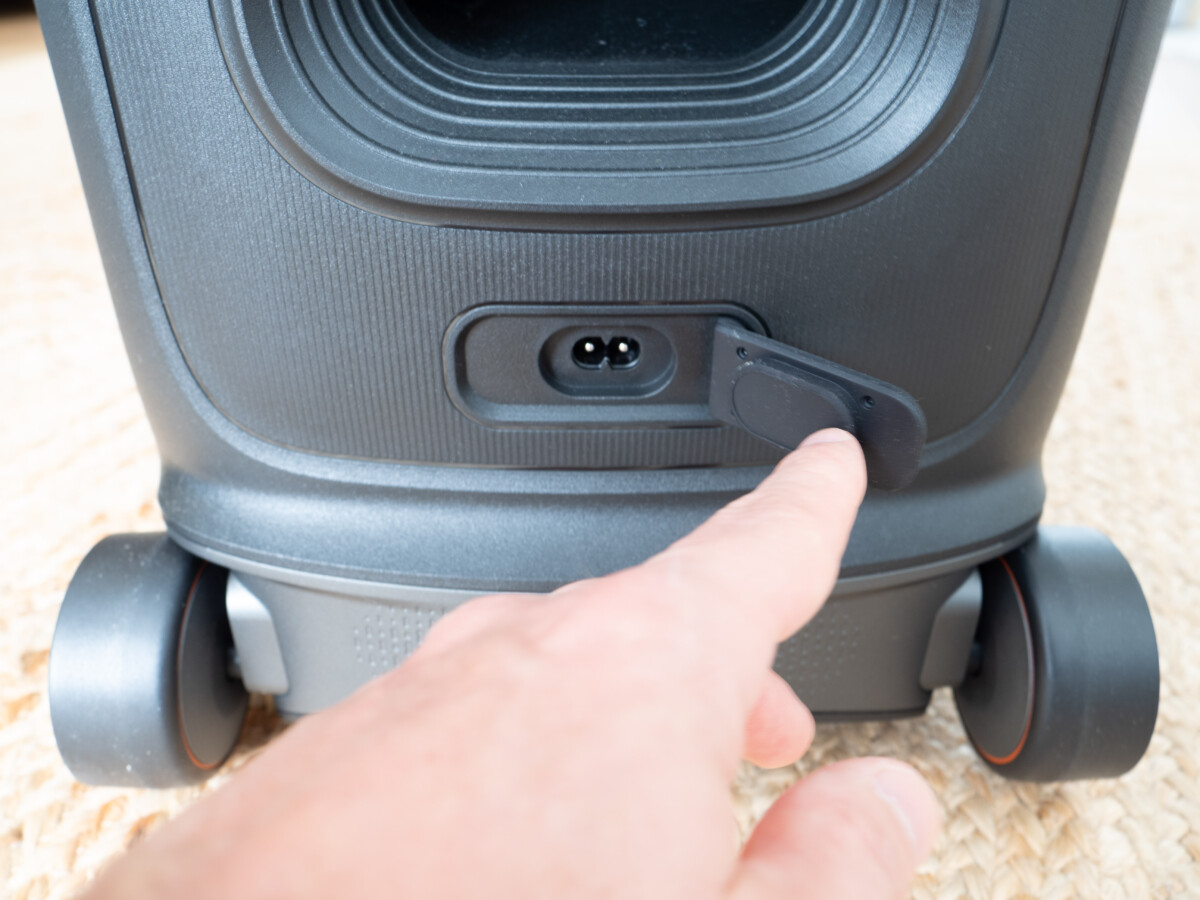
Moreover, the JBL PartyBox Stage 320 produces absolutely no parasitic noise when pushed to its limits. These two transducers reproduce in addition to bass sounds, mid-range sounds, while the pair of 2.5 cm tweeters take over only in the high frequencies.
JBL PartyBox Stage 320 Connections of the PartyBox Stage 320
The speaker is designed so that you can connect an external source, such as a portable music player, a CD player or even a vinyl turntable (with integrated preamplifier), via a 6.35 mm stereo jack socket. There is also a USB port, compatible with removable storage media and common audio files (MP3, FLAC, etc.), capable of providing 10 W of power to recharge a smartphone or any other device. Two microphone inputs, including one compatible with electric guitar, are present, with input gain adjustment. Finally, the JBL PartyBox Stage 320 is equipped with a pair of inputs and outputs for chaining multiple speakers together and playing the same music.
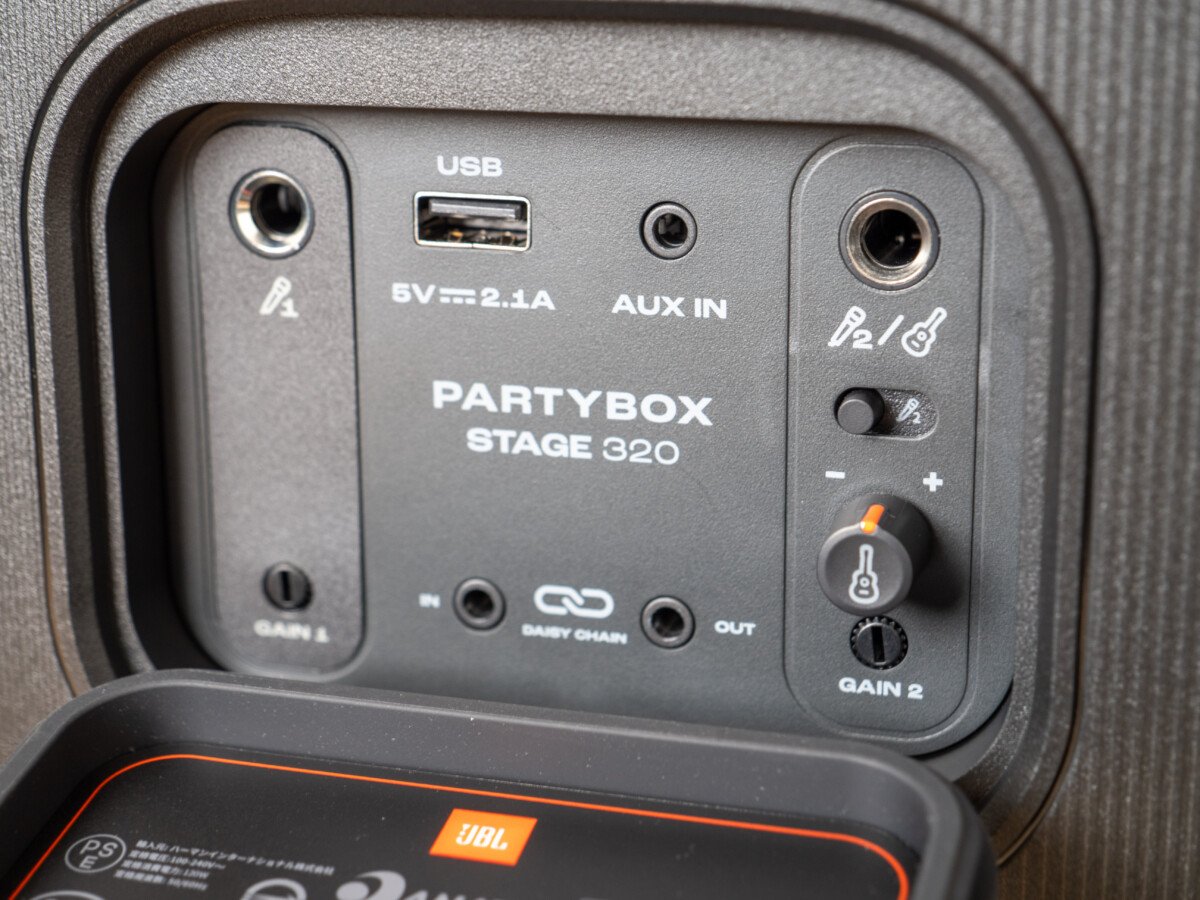
Obviously, this speaker is equipped with a Bluetooth controller and can receive music from a smartphone. The Bluetooth controller is also Auracast compatible, which allows you to combine multiple speakers to enhance immersion and sound volume.
JBL PartyBox Stage 320 Convenient tone settings
The speaker’s control panel is well made and there are enough settings to not necessarily use the JBL PartyBox application. However, this is useful for those who wish to finely personalize the lighting scheme and configure the colors for each of the four zones. The creation of sound effects is also provided, as is sound equalization (with 5 frequency keys). The PartyBox app is also useful for managing a set of Synchronized JBL speakers.
In short, this PartyBox is as easy to use as any Bluetooth speaker and offers advanced settings easily accessible, via potentiometers.
AI to listen louder?
According to JBL, the PartyBox Stage 320 would feature AI to exploit all the possibilities of its transducers, without the risk of damaging them. In other times, we talked about controlling the speakers, with optical sensors to measure the excursion of the membranes and adjust the power injected to prevent them from being damaged, by exceeding the maximum excursion value. (xmax). It’s not clear what AI could bring, but it doesn’t matter, the main thing being that this speaker can flirt with the technical limits of its components and thus offer intense sound volume.
JBL PartyBox Stage 320 She has it under the hood
JBL has integrated powerful amplification, capable of developing up to 240 W peak. This is at least ten times more than any portable compact speaker and, thus equipped, the PartyBox Stage 320 can play really loud while maintaining real tonal balance.
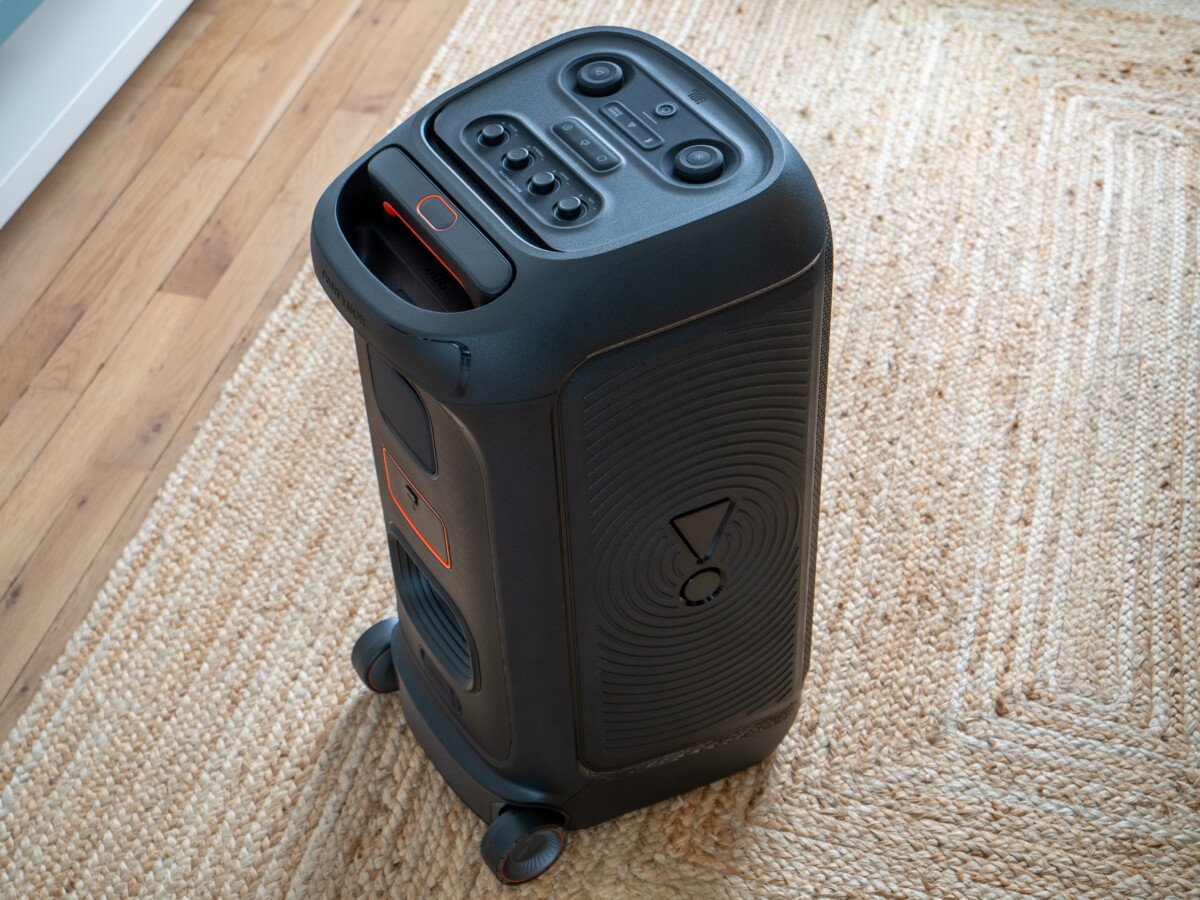
The sound signature of the PartyBox Stage 320 is similar to that of the Ultimate model, minus the exploration of the sub-bass. In other words, the sound produced is refined and presents an astonishing resolution for a festive speaker and even in absolute terms. The sound skillfully combines softness and firmness. Indoors, the listening mode that appealed to me the most was with the Bass Boost engaged (deep mode). The bottom of the spectrum is then generous, thick and well articulated. Outdoors, it is the second bass-boost mode which gives the best results. The speaker then hits more sharply and you can hear it clearly even though there is noise around you. Another good surprise, the voices are really beautiful, with chest resonances and an interesting range, in the absence of transducers dedicated to mid frequencies like on the PartyBox Ultimate. The treble is silky and precise. In short, from the first moment, this PartyBox Stage 320 seduces and we know that it is not a noise box that will tear out the eardrums. On the contrary, its analytical capacity should appeal to a large number of listeners.
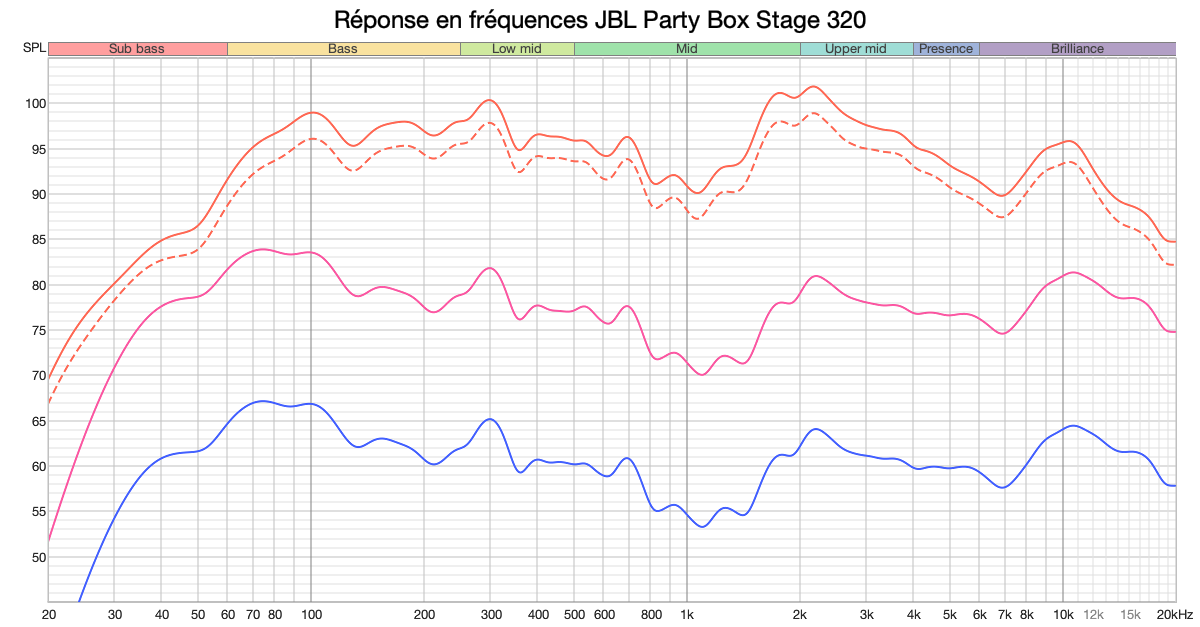
The three curves above show the behavior of the speaker at moderate volume (blue curve), high volume (pink curve) and at maximum power (orange curves). The JBL PartyBox Stage 320 goes down to 40 Hz (very deep bass), although with an attenuation compared to the high bass (70-100 Hz). In these conditions, you should not expect very physical bass – for that there is the Ultimate – but you can place the Stage 320 in the corner of a room to compensate and mechanically amplify the sub-bass. It is then very impressive considering its size, easily rivaling a subwoofer. Three peaks are notable when increasing the frequency: 300 Hz for the voice chest, 2 kHz to reinforce the resolution and around 10 kHz to give a little brilliance. Although there may be accidents all along the curve, the balance in the ear does not suffer.
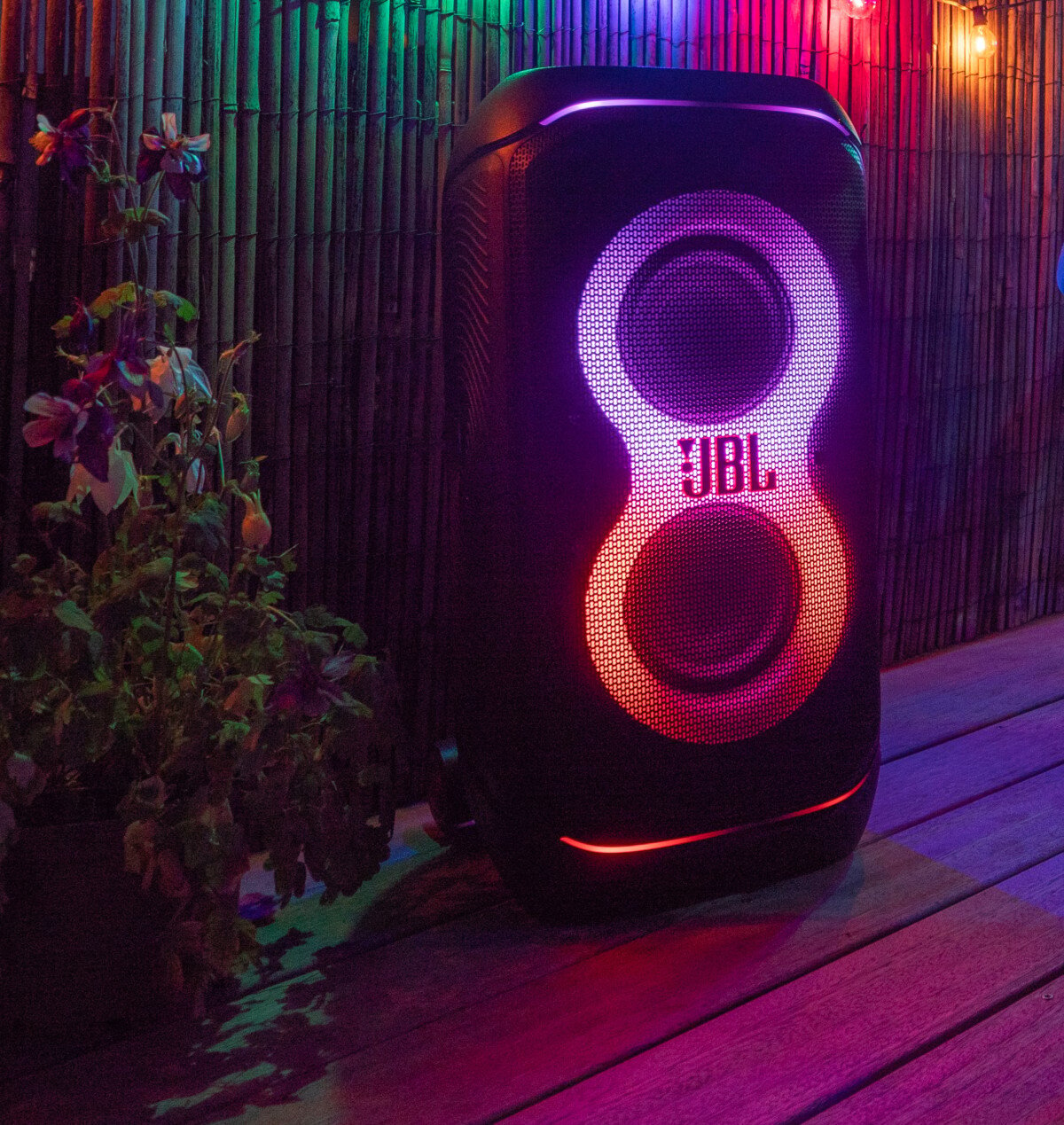
The JBL PartyBox Stage 320 is capable of producing an impressive sound volume, whether on mains or battery (dashed curve) where it loses little power, with an average level approaching 95 dB at 1 m. In these conditions, it’s impossible to hear each other speak and it’s enough to create quite an atmosphere outside.
Sound stage and dynamic behavior
The dynamic capabilities of the JBL PartyBox Stage 320 are at a very good level, with surprising differences when listening loudly. Conversely, the sound is full of detail at low volume. The restitution is always airy and fluid, with a good layering of sound planes in depth. On the other hand, the stage is not very wide despite the presence of two tweeters and stereo broadcast.
JBL PartyBox Stage 320 Valuable endurance
The removable 68 Wh battery of the JBL PartyBox Stage 320 gives it, according to JBL, an autonomy of up to 18 hours. This obviously depends on the volume chosen, the tone settings and the type of music. The louder you listen and with a lot of low frequencies, the more the autonomy will be reduced. That said, the 18 hours are perfectly achievable by listening at around 50% volume and, at this level, the speaker is already playing very loudly.
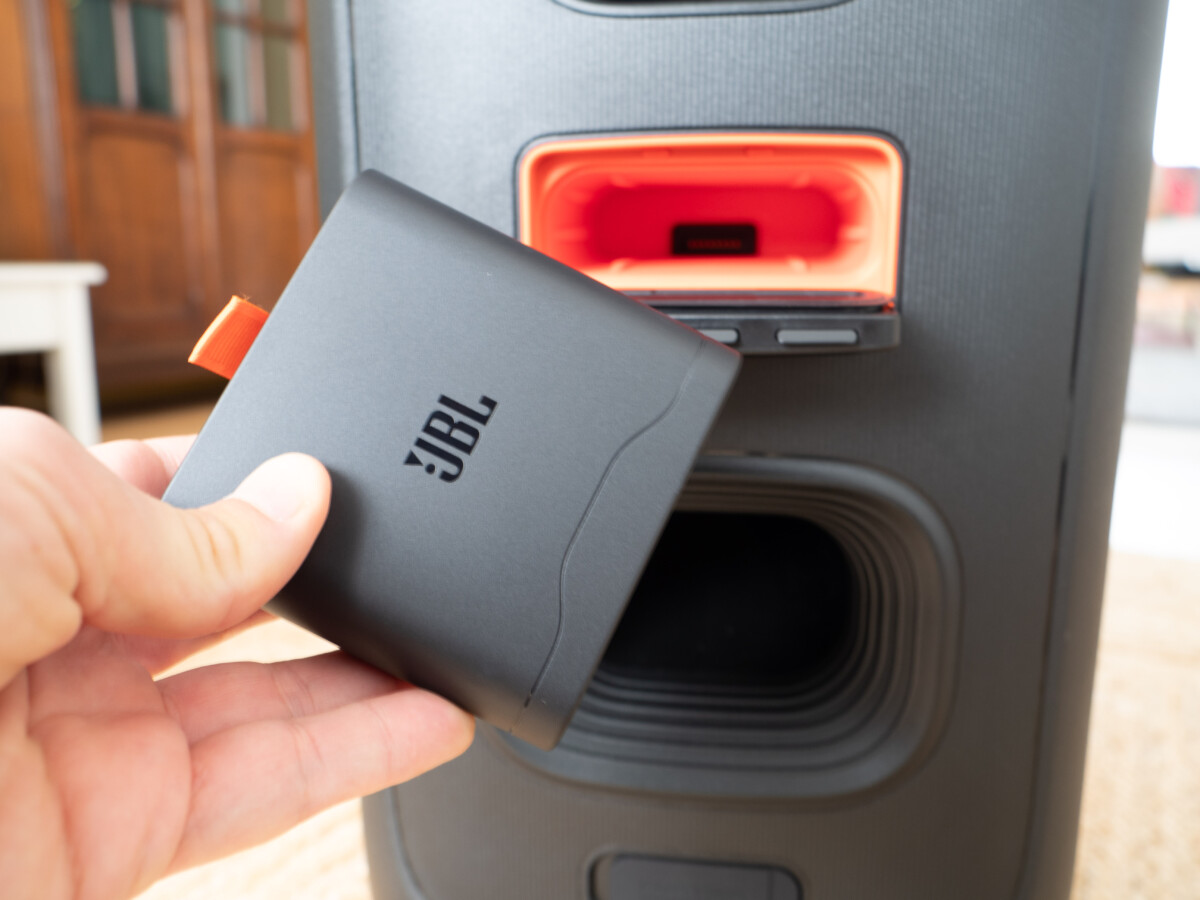
Beyond that, the amplification consumption increases exponentially and, at full power, it seems difficult to pass the 4 hour mark, especially if the bass boost is engaged. In this case, purchasing a second battery should be considered. Moreover, it takes 3 hours to fully recharge the battery, with the supplied mains cable.
JBL PartyBox Stage 320 Price and release date
The JBL PartyBox Stage 320 speaker is available for €599. An ultimately reasonable price if we consider that of the PartyBox Ultimate (€1599), certainly more powerful and devastating in the bass, with astonishing spatialization in Dolby Atmos. But two associated PartyBox Stage 320s would constitute a very valid alternative to the Ultimate, which is also completely portable thanks to battery operation.
Where to buy
JBL PartyBox Stage 320 at the best price?
